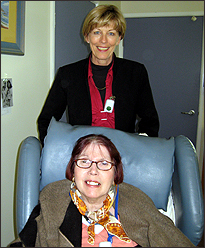PresCare, an Australian provider of elderly care, is using a Wi-Fi-based RFID system to enable residents to quickly and easily call for help when they need it. The medical alerting system notifies caregivers any time a resident wanders into a dangerous area or hasn’t moved for a long time, indicating they might need help.
PresCare operates five facilities and two community centers in Queensland. The company is using active tags and related hardware and software from San Mateo, Calif.-based real-time location system (RTLS) provider AeroScout.
The AeroScout system includes active 2.4 GHz RFID tags; exciters, which activate the tags, causing them to transmit their identification numbers; and the AeroScout Engine, which calculates tag locations by processing data from the tags and various Wi-Fi access points. The system also includes AeroScout’s MobileView software, which can portray location information on a map, in a table or in a report. Surecom, a local company, served as the systems integrator for the implementation.
PresCare began implementing the RTLS in mid-January at its Mount Tamborine site, says Ash Hanna, Surecom’s CEO, and has been running it since the beginning of February. About 100 tags are in use, says Joshua Slobin, AeroScout’s director of marketing. Affixed to lanyards that can be worn around the neck, the tags measure approximately 2 by 1.5 inches and a half-inch thick.
The tags are water-resistant and feature large, easy-to-find call buttons that residents can press when they are in trouble or need assistance. “PresCare wanted an emergency-alerting system that would give their residents full range of motion,” Slobin says. “They can go anywhere in the facility and not have to be necessarily watched over at all times—but if there was an emergency, they could press a button that would send an alert.” PresCare staff also wear the tags so they can easily issue an emergency alert.
When a tag’s call button is pressed, the tag transmits its unique ID number to a nearby Wi-Fi access point, which passes that information on to each staff member’s mobile handheld device, as well as to flat-screen monitors installed throughout the complex. AeroScout Exciters are positioned at doorways, exits and other chokepoints, to detect when residents move through them.
The system can locate the room in which a tag is located, and includes a set of configurable rules designed to trigger alerts when broken. For example, if the system fails to detect a tag’s movement for a specified amount of time, or detects that a resident has wandered into an off-limits or dangerous area, an alert can be issued.
According to Slobin, a caregiver responding to an emergency alert presses the call button on the resident’s tag in a predetermined pattern. This informs everyone involved that the call has been attended to.
So far, Hanna says, nurses and residents are satisfied with the system. Initially, he states, Surecom had set up an audible alert that sounded throughout the facility whenever a call button was pressed, but “we soon took it off, and the residents prefer the peace and quite.”
PresCare has already placed an order to install the system at a second site, Hanna notes, and is looking to implement it at a third site as well, by the middle of next year. When all three systems are up and running, more than 700 tags will be in use for 260 residents and all the staff.


